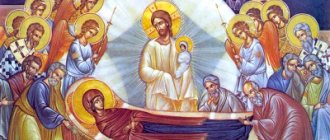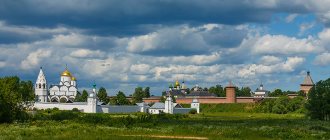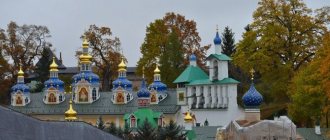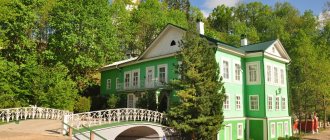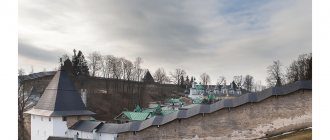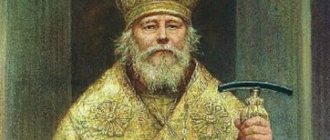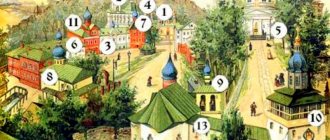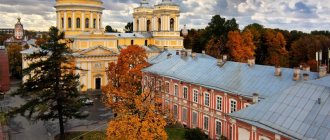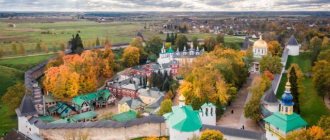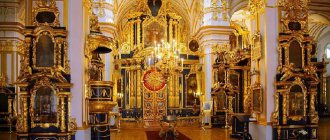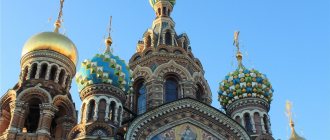Not every monastery was a fortress, and not every fortress in the Russian North serves as a monastery for monks. But if we are talking about the Holy Dormition Pskov-Pechora Monastery, then we need to note its uniqueness.
The monastery is located in a lowland, protected by hills and fortress walls
What, you ask, is its feature? Yes in everything! The Pechersk Monastery was built, contrary to common logic, in the valley of a stream, while other fortresses were always built on a hill.
Architects and builders succeeded in this idea quite well
The holy temple and monastery in Pechora, from the moment of its foundation, never stopped its monastic life and services, even if it was besieged and plundered by enemies.
It has all the attributes of a real fortress
What else is unique about the male Holy Dormition Pskov-Pechora Monastery? The fact is that, like all strongholds, it has:
- High walls.
- Observation towers.
- Fortified entrances.
As an object of early serf architecture, it is simply magnificent. And, if you have the opportunity to see the fortress in Pechora, be sure to go for a bright and strong impression. And she will help you organize your trip to Pskov with maximum comfort.
A trip to the Pskov-Pechersky Monastery, inspection of the courtyard and ancient burials, visiting the caves, walls and ramparts of the fortress will allow you to better understand the significance of a unique shrine in the history of Russia.
Flight over the monastery
Story
According to ancient legend, not far from Pskov, people from the Kiev Pechersk monastery lived in a cave, who fled to these lands due to numerous raids by the Crimean Tatars. The names of the hermits are unknown; only the name of one of them, St. Mark, has been preserved. However, the monastery on this site was founded much later, after the death of the monk.
In 1470, Hieromonk Jonah, a former priest of the St. George Church in the city of Yuryev (now the city of Tartu), settled in the cave, who built the Church of the Assumption of the Blessed Virgin Mary in a sandy hill near the Kamenets stream. The founding date of the temple is considered to be 1473, when the built church was consecrated.
Soon, the owner of the land on which the caves were located gave the ascetic this plot to found a monastery. Thus, on the western borders of Rus', 20 kilometers from the Livonian fortress of Neuhausen, the famous Pskov-Pechersky Monastery appeared.
In 1510, when Jonah had already died, the Pskov lands, and with them the monastery, became part of the Moscow state. From this time on, a new stage in the existence of the monastery begins.
Archimandrite Alypius – warrior of Christ
When the Commissioner for Religious Affairs arrived at the monastery with an order to close it, Archimandrite Alypiy , the monastery’s governor and a participant in the Great Patriotic War, refused to submit to the godless authorities. He threw the decree handed over by the official into the melted fireplace and said: “I would rather accept martyrdom, but I will not close the monastery. I have 60 monks, they will fight to the last man. We will dig up Peter’s cannons and organize a second defense of Stalingrad.”
It is not known what the party leadership would have done, but at that time the monastery was visited by Indian Prime Minister Indira Gandhi. Shocked by what she saw in the monastery, she cried and made a good advertisement for the monastery. Foreign delegations began to come here one after another, and the question of closure disappeared.
Strengthening the monastery
The monastery was located on the border between Russia and Livonia and was attacked more than once by the Germans, Swedes and Poles. Given this important strategic importance, the Moscow authorities are strengthening the monastery with fortress walls.
The largest work to strengthen the fortress was carried out under Ivan the Terrible, in 1552–1565. During the same period, the St. Nicholas Church with a bell tower was erected above the Holy Gate with the participation of Pavel Zabolotny (monastically Paphnutius).
The fortress walls and towers of the Pskov-Pechersky Monastery are built from local limestone, and the towers have different shapes and sizes.
The land on which the monastery is located is uneven and a stream flows through it. The construction of the walls was carried out taking into account these natural factors - the two towers of the fortress stand above streams flowing through specially installed gratings.
In 1570, bloody events took place in the monastery. Ivan the Terrible at the Holy Gate killed the abbot, hegumen Cornelius, and one of his students, Vassian Muromtsev.
According to legend, Ivan IV suspected the abbot of having connections with the boyar opposition; according to another version, in his writings Cornelius condemned the cruelty of the tsar. In connection with the tragic events, the road leading to the monastery was called the “Bloody Path”, since it was covered in blood when the monks carried the murdered abbot from the Holy Gate to the cave in which he was buried.
There was always a military garrison in the monastery, and in case of danger, local residents could take refuge here.
Complex of God-given caves
The complex of God-created caves consists of near and distant caves. The nearby U-shaped caves are 15 meters long. In them are tombs with the relics of Saints Mark, Jonah, Lazarus and Saint Vassa.
The nearby caves are followed by distant ones, consisting of 7 underground galleries - streets with the cave Church of the Resurrection of Christ. There is a monastery cemetery here, where 10,000 people are buried. The caves maintain a constant temperature of +5 degrees Celsius. From the entrance there are seven underground galleries. The monks of the monastery are buried within the walls of the fifth and sixth streets; they are called fraternal galleries.
In other galleries, pious laymen and military men are buried. At the end of the main street there is a kanun - a small table at which funeral services are held. Behind the eve is a large wooden cross.
The walls contain slabs with inscriptions and gravestones. The inscriptions contain the glorious names of the Suvorovs, Rtishchevs, and Nashchokins, Buturlins, and Mstislavskys. The ancestors of Alexander Pushkin, Kutuzov, Mussorgsky, as well as the ancestors of the Patriarch of Moscow and All Rus' Alexy are buried in the monastery caves.
Metropolitans, archimandrites, elders, monks and novices are buried here. In the monastery caves there are tombstones of Pskov, Toropets, Novgorod landowners and their families. The soldiers who defended the monastery during numerous wars are also buried in the caves. The caves of the monastery are the resting place of many saints, a place saturated with prayers, a necropolis that has no analogues.
The monastery during the war with King Stephen Batory
In 1581, during the war with the Polish king Stefan Batory, the fortress was fired upon from cannons, which pierced one of its walls. Russian soldiers went on the attack and repulsed the enemy.
Batory again sent his detachment to the fortress and ordered not to return without victory. This time the enemies destroyed the fortress wall on both sides and tried to take the fortress by storm, but again failed. As a result, the soldiers of Stefan Batory never took the monastery fortress.
In subsequent years, the fortress was attacked by Swedes, Polish troops and again by Swedes. Only once was the enemy able to break into the fortress: this happened at night, and in the morning the enemy was forced to leave the fortification.
The chronicle also testifies to the heroic defense of the defenders of the fortress against the detachments of Pan Lisovsky and Lithuanian Hetman Jan Chodkiewicz.
At the funeral table[edit]
- Archbishop Vladimir (Kobets, 1884-24.01.1960)
- Archimandrite John (Peasant, 1910-2006)
- Archimandrite Methodius (Kholmsky, 08/06/1831-1906)
- Archimandrite Nikita (Chesnokov)
- Archimandrite Seraphim (Rosenberg, 1909-1994)
- Valaam elders. Hieroschemamonk John, hieroschemamonk Mikhail (Pitkevich), schemamonk Nikolai (Monakhov). 1960
- Metropolitan Veniamin (Fedchenkov, 1880-1969).png
- Schema-Archimandrite Pimen (Gavrilenko, 1883-1976)
- Schemabishop Macarius (Vasiliev, 09/05/1871-03/31/1944)
- Schema-Hegumen Luka (Zemskov, 09/27/1880-12/02/1968)
- Schemamonk German (Sokolov, 1879-1965)
- Marble icon of the Lord Jesus Christ on the High Place in the cave church of the Resurrection of the Word. 1975
- Singing “Rest with the Saints” at the burial place of Archimandrite. John (Krestyankina). October 20, 2009
- Cave temple of the Resurrection of the Word. 1940
Here a prayer is performed for the departed, which is called a Panikhida...
After death, the human soul goes through “ordeals,” that is, a kind of private trial, where the whole life appears before the soul: good deeds and evil ones... The prayer of the Church, including the Memorial Service, alms for the deceased help the soul go through the ordeal and receive peace...
Buried at this place are: Archimandrite Methodius (Kholmsky), Metropolitan Veniamin (Fedchenkov), Archbishop Vladimir (Kobets), murdered Schemabishop Macarius (Vasiliev), Valaam elders, Archimandrite Seraphim (Rosenberg), elder Archimandrite John (Krestyankin).
Defense during the Northern War
By the beginning of the 18th century, the fortress was reinforced with earthen ramparts and bastions, and one of the bastions was founded by Peter the Great himself. In addition, earthen embankments and ditches were made. A new weapon was installed on the earthen bastions.
The Swedes attacked the Pskov-Pechersky Monastery in 1701, and then in 1703, but thanks to good fortification, all enemy campaigns were repulsed, and the enemy suffered significant losses.
In 1709, Russian soldiers under the leadership of Peter the Great won a victory near Poltava and the danger to the monastery decreased.
For some time, the fortress still continued to play the role of an important outpost on the western borders of the Russian state, but after the conclusion of the Treaty of Nystadt in 1721, the Pskov-Pechersky Monastery began to lose its military significance and remained only an important religious center in the north-west of the country.
How to get to Pechory from St. Petersburg?
You can get from St. Petersburg to Pechory without transfers by bus or by personal transport.
Bus
Travel time is 6 hours 20 minutes.
Departure to St. Petersburg from bus station No. 2 daily at 17:15.
To buy tickets
Automobile
Travel time is approximately 4 – 4.5 hours.
The distance between cities is 340 km.
Please note: you can get first to Pskov, and then from Pskov to Pechory.
Pskov-Pechersky Monastery - monuments
Among the surviving monuments the following can be noted:
- Church of St. Nicholas the Gatekeeper with a belfry from 1565
- St. Michael's Cathedral, located on a high place, was built in the classical style in 1827. This is the largest building, the dome of which is visible even at the entrance to the monastery
- To the east of the Assumption Church in 1523 a two-tier belfry with 17 bells was built
- The Annunciation Church, built by the Monk Cornelius in 1540, in 1870 the Sretenskaya Church was added to it
- The 17th-century sacristy, a three-tiered building, has a festive, elegant appearance: its walls are painted red, and the window casings and sashes are white.
- The Assumption Cave Cathedral is the main and oldest cathedral church, consecrated on August 15 (28), 1473, on the day of the great feast of the Dormition of the Blessed Virgin Mary.
The stone fortress walls with nine powerful towers survived:
- Taylovskaya
- The Tower of the Upper Grilles, distinguished by its slender proportions and height of almost 25 meters. In total, it has six combat tiers, and other towers have four or five tiers each
- The Tararygin Tower, destroyed by the Swedes in 1615, was restored in a slightly modified form
- The Izborsk Tower is interesting because its gates are protected by devices similar to the zakhabs of some fortresses of North-Western Rus' (zahabs are a long corridor that protected the fortress gates)
- Blagoveshchenskaya
- Tower of the Lower Lattices
- The Nikolskaya gate tower was built next to the Nikolskaya Church, erected during the time of Abbot Cornelius
- The passage Petrovskaya Tower was built after the Time of Troubles, in the 30s of the 17th century, then it was necessary to redo the section of the fortress walls closest to it
- Prison tower.
On the territory of the monastery, ancient battlements and loopholes, military passages and the remains of earthen fortifications erected under Peter I have also been preserved.
Eldership
The monastery has always attracted pilgrims: some went to the shrine, others for advice. In 1822, Emperor Alexander I came to Pechery to meet with Elder Lazar the Perspicious. On the third day after death, the elder, like Lazarus of the Four Days, a friend of Jesus Christ, rose from the grave and lived for another 16 years. In the conversation, the elder said to the sovereign: “Doing righteousness is a light for the king before the Heavenly Father. The life of a king should serve as an example for his subjects.”
Among the especially revered elders of the monastery is the Monk Simeon (1869-1960), who lived in the monastery for 67 years. The elder had the gift of insight and healing. In 1967, John Krestyankin became a monk of the monastery. During the last years of his life, the elder was seriously ill, but people from all over the country and from abroad came to him for consolation and advice.
How to get to Pskov from St. Petersburg?
Tourists who want to visit Pskov can fly by plane, come to the city by bus, train, electric train or car.
Please note: the schedule is subject to change, please check this information before your trip!
Airplane
Travel time – 1 hour.
Airport: Pulkovo
Departure time: 21:55
Train
Travel time is about 4 hours 18 minutes.
The train departs on Fridays from the Vitebsk station and arrives at the Pskov railway station.
Departure time: 18:50.
To buy tickets
Electric train
Travel time is 4 hours 12 minutes.
The train departs daily from the Baltic Station.
Departure time: 17:25.
Bus
Travel time is from 4 to 6.5 hours.
- Direct routes “St. Petersburg – Pskov”
Buses depart:
- From the Pulkovskaya Hotel, Moskovskaya metro station (Avtofavorit LLC), departure time - until September 14, daily at 07:00, 08:00, 10:00, 12:00, 14:00, 16:00, 18: 00, 20:00, 22:00. The exact schedule must be checked on the carrier’s website.
- From Vitebsky Station (Ecolines LLC), departure time is daily 22:40, Tue, Thu, Fri, Sun – 17:00.
- Transit flights
Buses depart from Bus Station No. 2, from the Chernyshevsky Monument, from Vitebsky Station, as well as from Zvezdnaya metro station. Departure times must be checked at information centers at bus stations.
To buy tickets
Automobile
Travel time is approximately 3.5 - 4 hours.
The distance between cities is 293 km.
Route – highway R-23.
Where to stay
Hotels, apartments, motels in Pechory
Tourists who come to see the Pskov-Pechersky Monastery can stay in one of the hotels in Pechora, for example, in the modern Pechory-Park Hotel (2b Gagarina St.), located 500 m from the monastery. The hotel has a café serving traditional Russian cuisine.
In addition, city guests can stay at the Planet Hotel (Mira St., 10): the average price per night here is almost 2 times lower compared to Pechory-Park, and the rooms are, accordingly, simpler. There is a restaurant on site. From the Planet you can walk to the monastery in 5 minutes.
The 12 Months Hotel (Oktyabrskaya Square, 6) is no less popular: there is a restaurant, hairdresser, and souvenir shop on the territory of the complex. The cost of a room per night varies depending on the level of comfort; the hotel is considered inexpensive.
In addition to hotels, tourists can choose various small private houses and apartments. Also in Pechory there is a hostel with a shared bathroom and kitchen for 8 rooms (Rizhskaya St., 75B) and the Voyage motel, located on Pribaltiyskoe Highway, 4b.
Houses for rent
If you are traveling with a large group, you will be interested in house rental options. For example, in addition to the usual 2-3 bed rooms in Pechory, you can rent a house for 10 people with 4 bedrooms at the address: st. Rizhskaya, 75. Complex "Pechory-Dom" on the street. Mira, 7 offers tourists the rental of 4 separate houses with 3 bedrooms (capacity of each house is 4-6 people).
Important: you need to book houses in advance, about a month in advance.
Pilgrim's House
If you want to fully experience the spirit of the monastery, we recommend staying at the Pilgrim’s House, opened in 2012 on the territory of a former military unit and located 2 km from the monastery.
Each cell in the “Pilgrim’s House” is designed for 4 people. The price includes two meals a day (lunch and dinner).
Please note: you can stay in the cell for 3 days.
The address of the pilgrimage center is Pechory, st. Yuryevskaya, 82.
Where to eat?
Firstly, you can have a snack in restaurants and cafes at hotels. Tourists living in private households can prepare their own food.
Secondly, right opposite the monastery there are many small cafes, for example, “Old Tower” (located a little further, 100 meters from the temple).
The third option, which will certainly appeal to all tourists without exception, is lunch at the Izborsky Ostrich eco-farm. The farm is located in the village of Zalavye, Pechora district, near Izborsk. Here you can not only enjoy delicious dishes, but also see a lot of interesting things - black African ostriches, Romanov breed sheep. Tourists will be able to purchase eco-cosmetics and eco-products.
Nutrition and obedience
- Nutrition . There are also no problems with food in the city. Opposite the monastery walls, at a distance of no more than 100 meters, there is a number of cafes with affordable prices. In addition, hotels have microwaves, electric kettles and the necessary sets of dishes.
- Workers . There is an opportunity to work in the monastery itself. This is possible for both sexes. Those who wish are assigned for obedience in the kitchen, refectory, food warehouse and other places. Such people are called workers. To get into their number, you need to contact the watchman located in the building where the brothers live. He will direct you to the hospitable monk.
